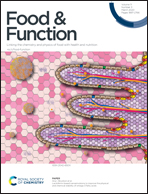Buffering capacity of commercially available foods is influenced by composition and initial properties in the context of gastric digestion†
Abstract
Buffering capacity is defined as the ability of a material to resist changes in pH after addition of acid or alkali. Food buffering capacity is important to consider during gastric digestion as it will impact the intragastric pH and gastric secretion rate. These factors will further influence the pepsin activity and acid hydrolysis, which will ultimately impact food breakdown and gastric emptying. The objective of this study was to determine the influence of composition and initial properties of thirty commercially available foods on buffering capacity. Protein content, fat content, particle size distribution, and buffering capacity were measured. A regression model was developed to evaluate which of the tested properties had the greatest contribution to the food buffering capacity. Overall, protein content and initial pH of the food were the most important factors in determination of buffering capacity. Foods were then classified into 6 classes based on their protein content. Foods in class 6, with higher protein content (average 22.3%), had significantly higher buffering capacity than foods in class 1, with lowest buffering capacity (average 0.6% protein) (p < 0.0001). Within dairy and meat products, higher fat content produced a lower buffering capacity. The interaction between initial properties and composition also influenced buffering capacity. For example, buffering capacity in foods with low protein content (<1.4%) was influenced by the organic acid content and initial pH. Particle size was an important factor for buffering capacity, but its role is influenced by protein content. Understanding the key factors contributing to the buffering capacity of foods is crucial for digestion studies as it will impact physicochemical and enzymatic reactions during digestion.



 Please wait while we load your content...
Please wait while we load your content...